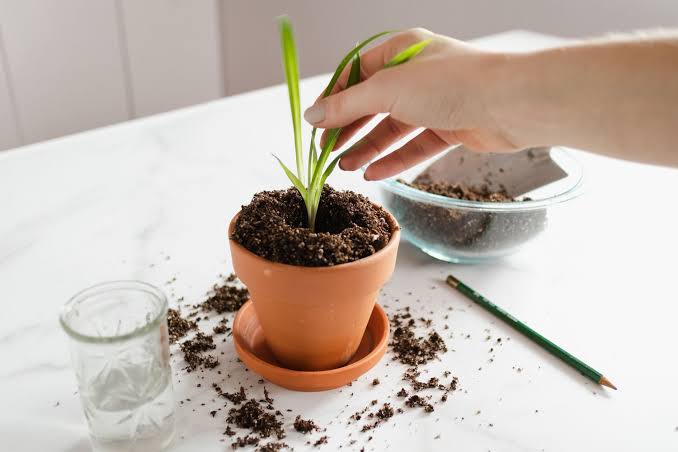Spider plants (Chlorophytum comosum) are beloved houseplants across the United States, United Kingdom, and Canada because they’re beautiful, resilient, and incredibly easy to care for. Known for their arching green-and-white striped leaves and adorable baby “spiderettes,” these plants bring a touch of freshness to any home. But one of the most exciting parts about owning a spider plant is how simple it is to multiply them.If you’ve been wondering how to get more plants for yourself or to share with friends, you’re in the right place. In this guide, we’ll cover 😋 easy how to propagate spider plant hacks you’ll want to save! You’ll learn different propagation methods, step-by-step instructions, and clever tricks that will help your spider plants thrive.H2: Why Propagate a Spider Plant?Spider plants naturally produce offshoots (baby plants) that dangle from long stems. Propagation is not only rewarding but also practical:Free plants – Grow new plants without spending extra money.Great gifts – Share healthy, thriving spiderettes with friends and family.Stronger parent plant – Removing spiderettes often encourages new growth.Fun project – A satisfying activity for beginner and experienced plant parents alike.With just a few simple steps, you can turn one plant into many.H2: The Main Methods of PropagationThere are several ways to propagate spider plants, each with its own benefits. Here’s a breakdown:H3: Water PropagationPlace spiderettes in a glass of water until roots form.Great for beginners because you can see the roots grow.Once roots are about 2 inches long, move to soil.H3: Soil PropagationPlant spiderettes directly in moist soil.Skip the water stage for faster establishment.Ideal if you already have potting mix and want less mess.H3: Division of the Mother PlantRemove the spider plant from its pot.Gently divide the root ball into sections.Replant each section into its own pot for instant full plants.H2: Step-by-Step Guide: Water PropagationHere’s one of the easiest hacks for how to propagate spider plants that even beginners will love:Identify Healthy Spiderettes – Look for baby plants that have small root nubs.Snip Carefully – Use clean scissors to cut the spiderette from the runner stem.Place in Water – Fill a glass or jar with room-temperature water and place the spiderette so the base is submerged.Wait for Roots – Change the water every few days. Roots usually appear within 1–2 weeks.Transfer to Soil – Once roots are 2 inches long, plant in a small pot with well-draining soil.This method is fun and almost foolproof.H2: Step-by-Step Guide: Soil PropagationIf you’d rather skip the water stage, follow these steps:Choose Spiderettes with Root Bumps – Tiny nubs at the base mean it’s ready to grow.Plant Directly in Soil – Fill a pot with a well-draining houseplant mix and gently press the spiderette in.Water Lightly – Keep soil slightly moist but not soggy.Provide Bright, Indirect Light – Avoid direct sun, which may scorch the delicate new plant.Check Growth – After a few weeks, give a gentle tug to feel resistance, a sign roots have taken hold.This is one of the most 😋 easy how to propagate spider plant hacks you’ll want to save!H2: Dividing the Mother PlantIf your spider plant has outgrown its pot, division is the perfect hack:Remove the Plant from Its Pot – Loosen the soil and carefully slide the plant out.Separate Sections – Look for natural divisions in the root ball.Cut if Necessary – Use a clean knife if roots are tangled.Repot Each Section – Plant each division in its own pot with fresh soil.Water and Care – Treat them like mature plants right away.This method instantly gives you multiple full plants, not just baby spiderettes.H2: Clever Hacks for Faster PropagationWant to speed up or improve your propagation success? Try these tricks:Keep humidity high – Cover new plants with a clear plastic bag to create a mini greenhouse.Use rooting hormone – Dip spiderette bases into powder to encourage root growth.Don’t overcrowd jars – Give each baby plant its own space to prevent rot.Choose the right season – Spring and summer are the best times since plants are actively growing.Start small – Use small pots first before transferring to larger ones as the plant matures.H2: Common Mistakes to AvoidEven though spider plants are hardy, a few missteps can slow down propagation:Overwatering – Leads to root rot. Keep soil damp, not soggy.Too little light – Without enough indirect light, roots develop slowly.Cutting too early – Babies without root nubs may struggle to survive.Forgetting to refresh water – Stagnant water breeds bacteria and can harm roots.Avoid these pitfalls, and your propagation efforts will be a breeze.H2: How to Care for Propagated Spider PlantsOnce your new plants are established, proper care ensures they thrive:Lighting: Bright, indirect light is best.Watering: Allow the top inch of soil to dry before watering.Soil: Use a well-draining houseplant mix.Fertilizing: Feed monthly during the growing season with balanced liquid fertilizer.Repotting: As they grow, move to larger pots to avoid root crowding.Treat them well, and soon you’ll have a lush indoor jungle.H2: Fun Ways to Use Extra Spider PlantsWith so many new plants, what should you do? Here are some ideas:Gift Them – A potted spiderette makes a thoughtful, living present.Create a Hanging Display – Group several pots together for a cascading green effect.Office Decor – Brighten up workspaces with easy-care greenery.Plant Swap Parties – Trade your spider plants for other varieties.Propagation isn’t just about multiplying plants—it’s about sharing joy and greenery.ConclusionSpider plants are not only one of the most resilient houseplants but also among the easiest to propagate. Whether you choose water propagation, soil planting, or dividing the parent plant, you’ll find it simple and rewarding. With these 😋 easy how to propagate spider plant hacks you’ll want to save!, you’ll soon have a collection of thriving spider plants to enjoy and share.So grab your scissors, a few jars, and some soil—it’s time to grow your spider plant family. Once you start, you may never stop!

